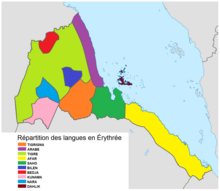Nara people
| Total population | |
|---|---|
| 108,000[1] | |
| Regions with significant populations | |
| Languages | |
| Nara | |
| Religion | |
| Predominantly:Islam[2] | |
| Related ethnic groups | |
| Kunama |
TheNaraare an ethnic group inhabiting southwesternEritrea.The society is divided into four subtribes, who are traditionally animist. They are mostly subsistence farmers.

Overview
[edit]According to the Eritrean government, the Nara are descendants of the firstNilo-Saharansettlers in Eritrea, who had migrated from theUpper Nilearea and intermarried with localPygmypopulations.[3]
Today, the Nara number around 108,000 individuals.[1]They constitute around 1.5% of the population of Eritrea.[2]They are typically agrarian and have settled primarily along the border withSudan.[4]
They area located north of the Kunama, in the western parts of Barka Plains, the Nara constitute about 1.5% of the Eritrean population.[5]
The Nara population is divided into four subtribes: the Higir, Mogareb, Koyta and Santora.[1]They traditionally adhered toanimistbeliefs.[6]By the 15th century the Nara were introduced to Islam and after theEgyptianoccupation in the 19th century, most Nara adoptedIslam.[2][7]
The Nara ethnonym means "Sky Heaven".[6]They also used to call themselves theBarya.[8][9]

Language
[edit]The Nara people speak theNara languageconsidered alanguage isolatein typological research but which has been grouped with the hypotheticalNilo-Saharanlanguage family. Through contact with neighboringAfroasiatic-speaking populations, many Nara are also bilingual inTigreand/orArabic.They traditionally had no writing system, with the few existing pieces of literature in Nara transcribed using the writing system of either Tigre or Arabic.[2]
The language is also known asNara-Bana,meaning "Nara-Talk".[6]
Social organization
[edit]Social organisation of the Nara people is based on the clan and subclan, with people living in villages and hamlets. The lineage system is patrilineal, unlike that of theKunama people.Land belongs to the clan and shared out among the families in the clan.[2]
Genetics
[edit]According to Trombetta et al. (2015), 60% of Nara are carriers of theE1b1bpaternal haplogroup. Of these, around 13% bear the V32 subclade, to which belong 60% of theTigreSemiticspeakers in Eritrea. This points to substantial gene flow from neighbouringAfro-Asiatic-speaking males into the Nara's ancestral community.[10]Cruciani et al. (2010) likewise observed that the remaining Nara individuals are primarily carriers of the Afro-Asiatic-associated haplogroupJ(20%), as well as theAlineage (20%), which is instead common among Nilotes.[11]
References
[edit]- ^abc"Nara".Ethnologue.Retrieved20 July2016.
- ^abcdeMussie Tesfagiorgis G. (2010).Eritrea.ABC-CLIO. p. 177.ISBN978-1-59884-231-9.
- ^"The people of Eritrea".Ministry of Information, Eritrea.Retrieved20 July2016.
- ^Killion, Tom (1998).Historical Dictionary of Eritrea.ISBN978-0-8108-3437-8.
- ^Tesfagiorgis, Mussie G. (2010-10-29).Eritrea.ABC-CLIO.ISBN978-1-59884-232-6.
- ^abc"Eritrea: Nara People's History".Archived fromthe originalon 2018-05-23.Retrieved2010-02-09.
- ^Killion, Tom (1998).Historical dictionary of Eritrea.Lanham, Md.: Scarecrow Press.ISBN978-0-8108-3437-8.
- ^Cavalli-Sforza, L. Luca;Menozzi, Paolo; and Piazza AlbertoThe History and Geography of Human GenesPrinceton, New Jersey: 1994 Princeton University Press "Ethiopians, Some of Their Neighbors, and North Africans" Page 173
- ^Woldemikael, Tekle M. "Language, education, and public policy in Eritrea." African Studies Review 46.1 (2003): 117-136.
- ^Beniamino Trombetta; Eugenia D'Atanasio; Andrea Massaia; Marco Ippoliti; Alfredo Coppa; Francesca Candilio; Valentina Coia; Gianluca Russo; Jean-Michel Dugoujon; Pedro Moral; Nejat Akar; Daniele Sellitto; Guido Valesini; Andrea Novelletto; Rosaria Scozzari; Fulvio Cruciani (2015)."Phylogeographic refinement and large scale genotyping of human Y chromosome haplogroup E provide new insights into the dispersal of early pastoralists in the African continent".Genome Biology and Evolution.7(7): 1940–1950.doi:10.1093/gbe/evv118.PMC4524485.PMID26108492.
- ^Cruciani, Fulvio; et al. (2010)."Human Y chromosome haplogroup R-V88: a paternal genetic record of early mid Holocene trans-Saharan connections and the spread of Chadic languages".European Journal of Human Genetics.18(7): 800–807.doi:10.1038/ejhg.2009.231.PMC2987365.PMID20051990.;Supplementary Table 3
